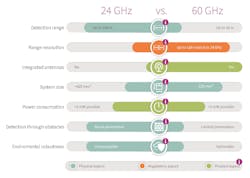Range-Detection Technologies Target Consumer and Commercial Apps
Check out our Sensors Converge 2023 coverage.
What you will learn:
- Why range-sensing applications are becoming more common.
- What’s the difference between radar and optical sensing?
- Why these sensors are better than using passive-infrared (PIR) technology.
Anyone remember when radar and optical time-of-flight (ToF) sensors were very expensive, hard to design in, and so on? It wasn’t that long ago and the thought of using them in consumer and commercial applications, other than specialized applications like avionics and automotive, was considered fantasy land.
But not anymore. Kim Lee, Senior Director of Systems Applications Engineering for Sensors, Solutions and IoT at Infineon Technologies Americas, shows some demos of these technologies in the video (watch the video above).
While passive-infrared (PIR) technology has been the go-to solution for low-cost motion detection applications, it has severe limitations when it comes to providing more information than just a presence indication. Alternatives like radar and optical time-of-flight (ToF) sensors provide significantly more accurate and detailed information, yet the cost and complexity of the systems used to be significantly higher and thus prohibitive.
These days, ToF and radar sensors are not only economical for many applications, but they provide 3D sensing capabilities like Infineon’s Real3 3D image sensors (Fig. 1). The REAL3 3D ToF sensors work with infrared illumination so that the system will work in the dark. It utilizes 850- or 940-nm infrared sources.
Infineon’s XENSIV 24- and 60-GHz radar sensors target industrial, commercial, and consumer applications (Fig. 2). They can include fully integrated microwave radar motion sensors with antennas-in-package (AIP) that are capable of detecting motion and the direction of motion. The systems consume as little as 5 mW.
The company also has solutions that target other markets, such as rugged and automotive applications. Some of the products mentioned above that are aimed at the industrial and consumer space may also find their way into rugged and automotive spaces, performing operations such as tracking drivers and occupants.
Furthermore, 3D sensors can provide additional functionality like gesture detection. This is often done by the host processor using incoming depth map frames. These have the advantage over video sensors from a privacy standpoint because there’s no video information to record.
Check out more of our Sensors Converge 2023 coverage.
Links
About the Author
William G. Wong
Senior Content Director - Electronic Design and Microwaves & RF
I am Editor of Electronic Design focusing on embedded, software, and systems. As Senior Content Director, I also manage Microwaves & RF and I work with a great team of editors to provide engineers, programmers, developers and technical managers with interesting and useful articles and videos on a regular basis. Check out our free newsletters to see the latest content.
You can send press releases for new products for possible coverage on the website. I am also interested in receiving contributed articles for publishing on our website. Use our template and send to me along with a signed release form.
Check out my blog, AltEmbedded on Electronic Design, as well as his latest articles on this site that are listed below.
You can visit my social media via these links:
- AltEmbedded on Electronic Design
- Bill Wong on Facebook
- @AltEmbedded on Twitter
- Bill Wong on LinkedIn
I earned a Bachelor of Electrical Engineering at the Georgia Institute of Technology and a Masters in Computer Science from Rutgers University. I still do a bit of programming using everything from C and C++ to Rust and Ada/SPARK. I do a bit of PHP programming for Drupal websites. I have posted a few Drupal modules.
I still get a hand on software and electronic hardware. Some of this can be found on our Kit Close-Up video series. You can also see me on many of our TechXchange Talk videos. I am interested in a range of projects from robotics to artificial intelligence.


